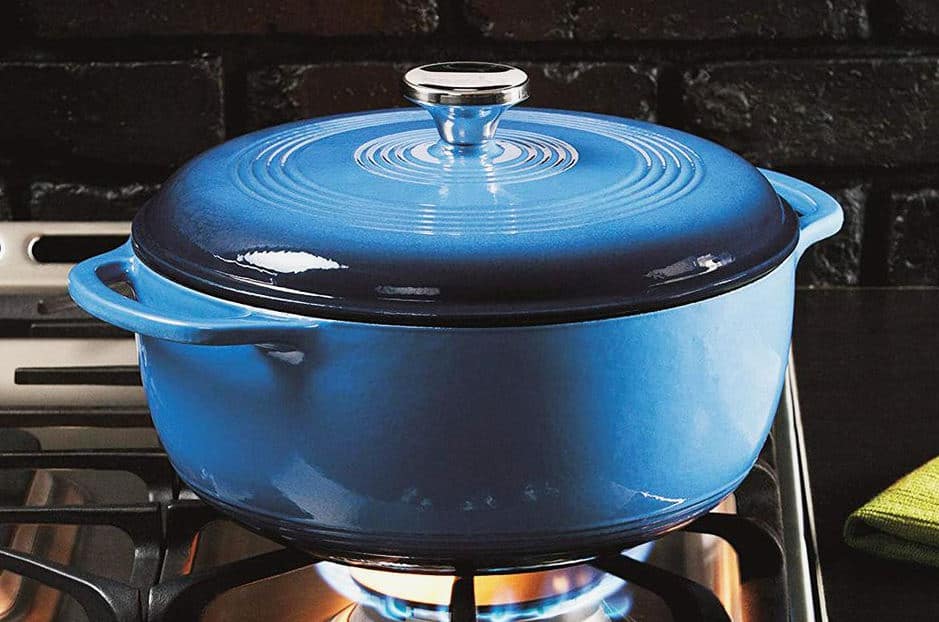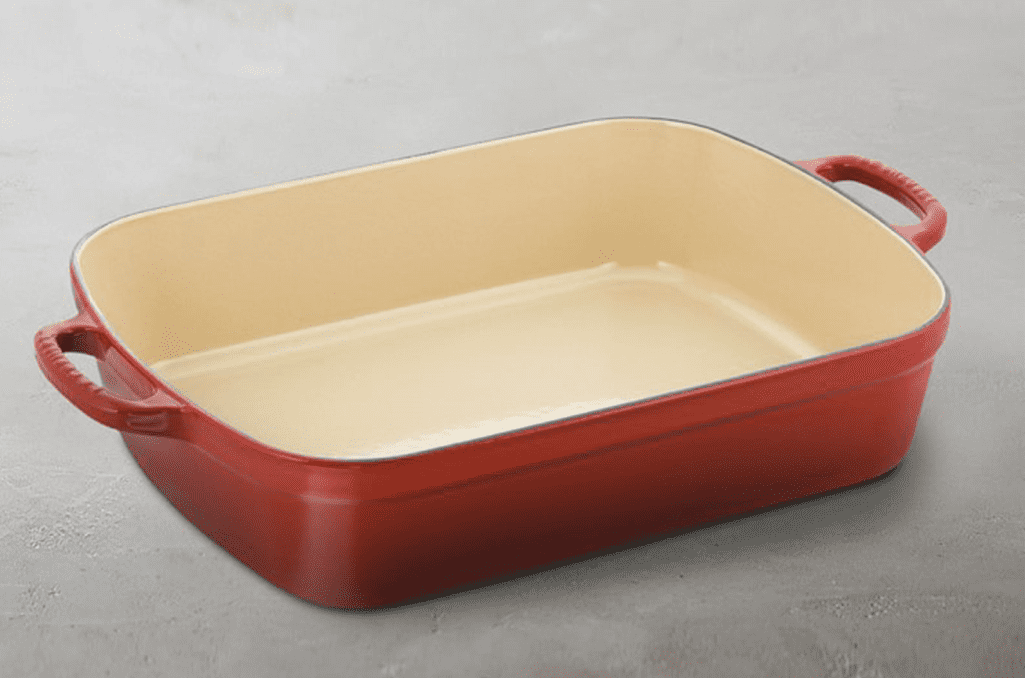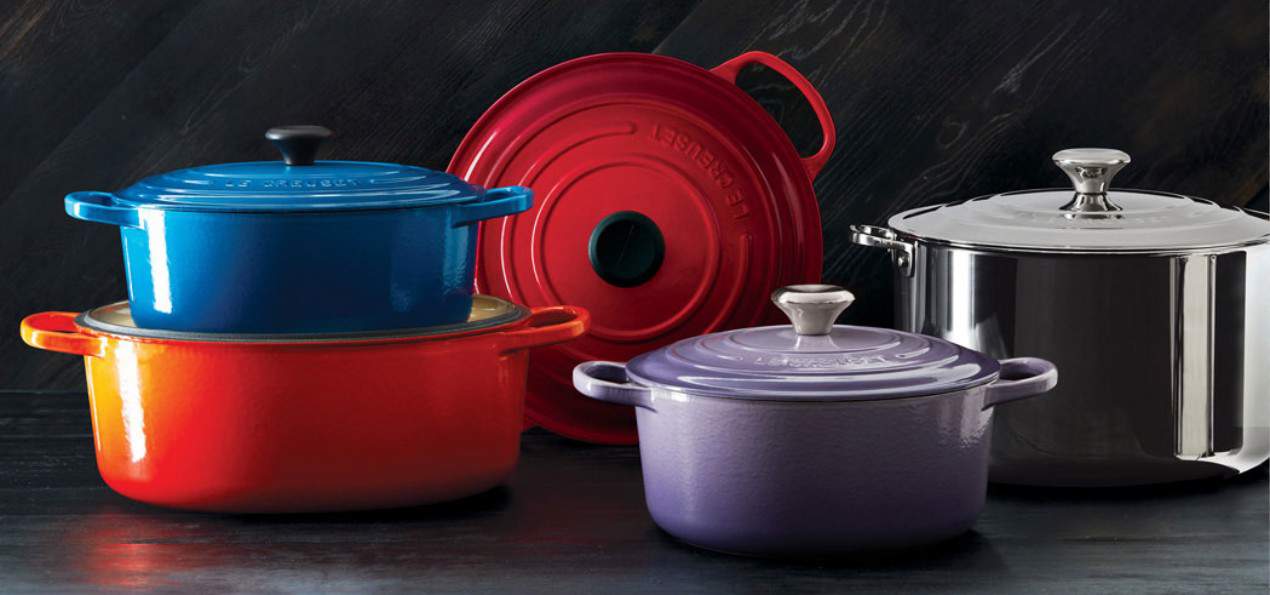Producing outstanding meals requires fresh ingredients, exceptional cooking techniques, and proper and good-quality cookware. Who would want to turn down a slice of delicious roasted meat?
But what should we use to achieve it? A dutch oven or a roast pan? Find out and bring the best out of your dishes!
What is a Dutch Oven?

The Dutch oven is multifunctional cookware consisting of high, thick, and deep walls. The dutch oven lid also gives good air circulation that helps with even cooking.
Traditionally, a Dutch oven was used over an open fire or hot coals, making it suitable for both outdoor and indoor cooking. However, these days, the type of dutch ovens that are usable on stovetops are more popular because they are suitable for home and indoor cooking.
While most Dutch ovens are made of cast iron, they are also available in various materials and qualities.
What is Roasting Pan?

A roasting pan is a shallow pan that comes with a removable rack. There are roasting pans with domed lids that ensure even cooking, but most don’t have it since it is commonly used with dry heat in an oven.
It may come as no surprise that a roasting pan is primarily for roasting food, which involves browning and crisping food.
Roasting pans are typically made of stainless steel or anodized aluminum, although other materials are also available.
4 Differences Between a Dutch Oven and a Roasting Pan
Though dutch ovens and roasting pans are pretty similar in use, they still have differences that make each unique in design.
So, if you are still undecided over what cookware you should use, we will provide you with the differences between the two. The function comparison could help you determine the proper cookware that can suit your kitchen needs.
Size
Dutch ovens usually range in size from 5-8 quarts, suitable for cooking dishes for about four people. However, Dutch ovens are available in sizes ranging from 1 to 13 quarts.
For size preference, in a one quart dutch oven, you could cook side dishes and a small number of desserts. You can also use it for simmering sauces.
In comparison, the 13 quarts dutch oven lets you cook a meal that fits up to twelve people. You can also roast a regular-sized chicken on it, perfect for sharing in a gathering.
Like the dutch oven, roasting pans are also available in various sizes. It’s available from a 14-19 inches pan. A 14-inch roasting pan can carry small sizes of poultry that weigh up to 12 pounds. In comparison, the 19-inch roasting pan can cook a larger quantity of poultry and meats that weigh up to 20 pounds.
Shape
A dutch oven has two types of shapes, round and oval. The round shape is perfect for cooking soups and stews, while the oval roasts poultry.
Roasting pans also come in two shapes, oval and rectangle, suitable for roasting.

Function
- Roasting – With roasting, you can use both the dutch oven and roasting pan. However, a roasting pan produces browner and crisper results. You could still use a dutch oven to achieve brown and crispy meats, but you still have to find and use a rack that fits inside it.
- Baking – A dutch oven is incredible for baking dough and bread because of its lid’s naturally generated steam inside the pot. Surprisingly, even though baking is not the primary purpose of roasting pans, you can still use them for baking. It’s excellent for baking dishes that need steam or moisture. All you have to do is place the formed dough in the rack and let it sit in an oven over your preferred time. Roasting pans can also serve as an alternative for baking trays.
- Stews and Soups – If you want to make stew and soups, a dutch oven is highly recommended for you since it can retain heat nicely. The moisture and excellent air circulation inside the pot will cook the meat and vegetable evenly. Using the dutch oven can also lead to a rich and flavorful broth. Roasting pans are not typically used in stewing but can also heat leftover soups and stews.
- Braising – Braising is a cooking method where you cook the meat for an extended period in low heat. In this cooking method, you can use both cookware. The only difference is when you use a roasting pan, you will still need an oven because braising requires a tightly sealed container which is natural for a dutch oven.
Materials

If you want to produce delicious dishes and have the best cooking experience, you must also check the quality of the cookware that you will purchase and use by determining the materials used to make it.
During old times, dutch ovens were made out of expensive materials like copper and brass, but later on, they discovered that cast irons were cheaper and a better alternative.
These days, dutch ovens are typically made with cast iron, ceramic, and aluminum, while the surface is usually coated with enamel.
On the other hand, roasting pans have different types that vary according to the materials used to make them. Here are some of the materials that are commonly used:
- Aluminum Foil – If you are on a tight budget, this type of roasting pan might be good for you. Aluminum foils are much cheaper but are also disposable.
- Stainless Steel – This kind of roasting pan is excellent in use because of its non-stick coating. With stainless steel, tough stains can be easily removable with vinegar and baking soda solution.
- Coated Enamelware – The enameled roasting pan comes with a non-stick coating that helps clean the cookware much easier and faster.
- Cast-Iron – If you want a roasting pan compatible with the stovetop, you could choose the cast iron roasting pan. Cast irons can be used for roasting meat on a stove before putting it in an oven.
What Cookware Should I Use?

In choosing the most suitable cookware for you, there are factors that you must consider. You don’t have to worry! We are here to help you decide.
Meat Size
If you plan to cook smaller meat cuts and small-sized poultries, a dutch oven might be suitable for you. Roasting pans are better suited for cooking larger poultry, such as turkeys.
Serving Size
One of the factors that you should consider in choosing your cookware is the size of the serving.
If you are going to cook for a smaller family, a dutch oven might be the one for you. The larger dutch oven size can provide meals for up to twelve people.
The roasting pan is excellent for larger or multiple servings, so if you plan to serve in larger events with bigger groups of people, this one might suit you best.
Storage Space
If you don’t have much space in your house or kitchen, you can choose a roasting pan. It has a well-built handle on both sides so that you can hang it on pot racks.
Purchasing a dutch oven can cost you more space because you should store it on a cupboard or a cabinet because of its deeper walls and larger size.
Cost of Pans
The cost of the pans depends on their size and the materials used. Although as a rule of thumb, the dutch oven can cost more than roasting pans, but you can still find some budget-friendly options.
How to Properly Clean Your Dutch Oven and Roasting Pan?

For your cookware to last for a long time, cleanliness must be one of your priorities.
To clean a Dutch oven and roasting pan, use dishwashing liquid and scrub with a non-abrasive sponge or soft cloth to avoid scratches.
However, if you experience having tough stains or burnt areas on your cookware, you could use vinegar and baking soda solution to get rid of it.
To clean with a vinegar-baking soda solution, you must check these two methods:
Method 1
- Sprinkle a good amount of baking soda directly on the stain or burnt area, then gently pour vinegar on it. Let it sit for a few minutes before rinsing.
- Once you have washed the solution, let your cookware soak in hot water for half an hour.
- Then, scrub your cookware. Use a spatula if you need to scrape hardened stains. Repeat the process until the pan is clean.
- Lastly, dry the cookware before storing it.
Method 2
- In a bowl or a container, combine a half cup of water, 2/3 cups of baking soda, and two tablespoons of vinegar. You could add a tablespoon of dishwashing liquid if available.
- Stir the ingredients until dissolved and pour the mixture into a spray bottle. Then spray it over the stains on your cookware.
- Scrub off the stain until the cookware is clean, then rinse.
- Dry the pan with a washcloth.
Storing
Never store your cookware dirty. Ensure that it’s well-dried and clean before placing it on a shelf or cabinet to avoid rusting.
We recommend keeping it in a dry place, far away from moisture and steam.
In summary
Dutch oven and roasting may be similar in some functions and other factors, but they still have differences in pros and cons. Hopefully, this article helps you determine which cookware is suitable for your need.


Michael Johnson is the founder of Pan Mastery, Inspired by his blacksmith grandfather’s legacy has a deep appreciation for hand-crafted pots and pans, he provides invaluable guides, reviews, and recipes to enhance your culinary journey.
